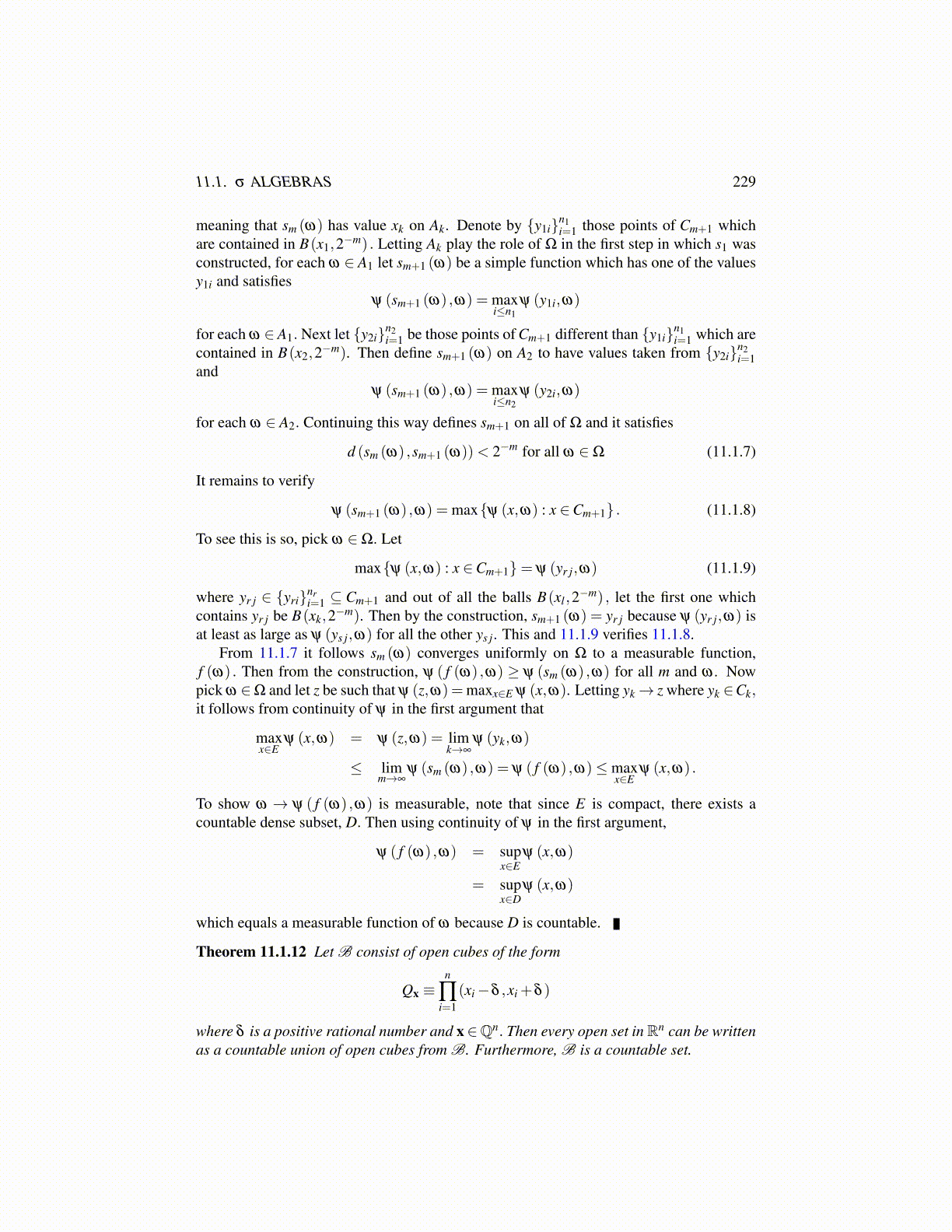
11.1. σ ALGEBRAS 229
meaning that sm (ω) has value xk on Ak. Denote by {y1i}n1i=1 those points of Cm+1 which
are contained in B(x1,2−m) . Letting Ak play the role of Ω in the first step in which s1 wasconstructed, for each ω ∈ A1 let sm+1 (ω) be a simple function which has one of the valuesy1i and satisfies
ψ (sm+1 (ω) ,ω) = maxi≤n1
ψ (y1i,ω)
for each ω ∈ A1. Next let {y2i}n2i=1 be those points of Cm+1 different than {y1i}n1
i=1 which arecontained in B(x2,2−m). Then define sm+1 (ω) on A2 to have values taken from {y2i}n2
i=1and
ψ (sm+1 (ω) ,ω) = maxi≤n2
ψ (y2i,ω)
for each ω ∈ A2. Continuing this way defines sm+1 on all of Ω and it satisfies
d (sm (ω) ,sm+1 (ω))< 2−m for all ω ∈Ω (11.1.7)
It remains to verify
ψ (sm+1 (ω) ,ω) = max{ψ (x,ω) : x ∈Cm+1} . (11.1.8)
To see this is so, pick ω ∈Ω. Let
max{ψ (x,ω) : x ∈Cm+1}= ψ (yr j,ω) (11.1.9)
where yr j ∈ {yri}nri=1 ⊆ Cm+1 and out of all the balls B(xl ,2−m) , let the first one which
contains yr j be B(xk,2−m). Then by the construction, sm+1 (ω) = yr j because ψ (yr j,ω) isat least as large as ψ (ys j,ω) for all the other ys j. This and 11.1.9 verifies 11.1.8.
From 11.1.7 it follows sm (ω) converges uniformly on Ω to a measurable function,f (ω) . Then from the construction, ψ ( f (ω) ,ω) ≥ ψ (sm (ω) ,ω) for all m and ω . Nowpick ω ∈Ω and let z be such that ψ (z,ω) =maxx∈E ψ (x,ω). Letting yk→ z where yk ∈Ck,it follows from continuity of ψ in the first argument that
maxx∈E
ψ (x,ω) = ψ (z,ω) = limk→∞
ψ (yk,ω)
≤ limm→∞
ψ (sm (ω) ,ω) = ψ ( f (ω) ,ω)≤maxx∈E
ψ (x,ω) .
To show ω → ψ ( f (ω) ,ω) is measurable, note that since E is compact, there exists acountable dense subset, D. Then using continuity of ψ in the first argument,
ψ ( f (ω) ,ω) = supx∈E
ψ (x,ω)
= supx∈D
ψ (x,ω)
which equals a measurable function of ω because D is countable.
Theorem 11.1.12 Let B consist of open cubes of the form
Qx ≡n
∏i=1
(xi−δ ,xi +δ )
where δ is a positive rational number and x∈Qn. Then every open set in Rn can be writtenas a countable union of open cubes from B. Furthermore, B is a countable set.